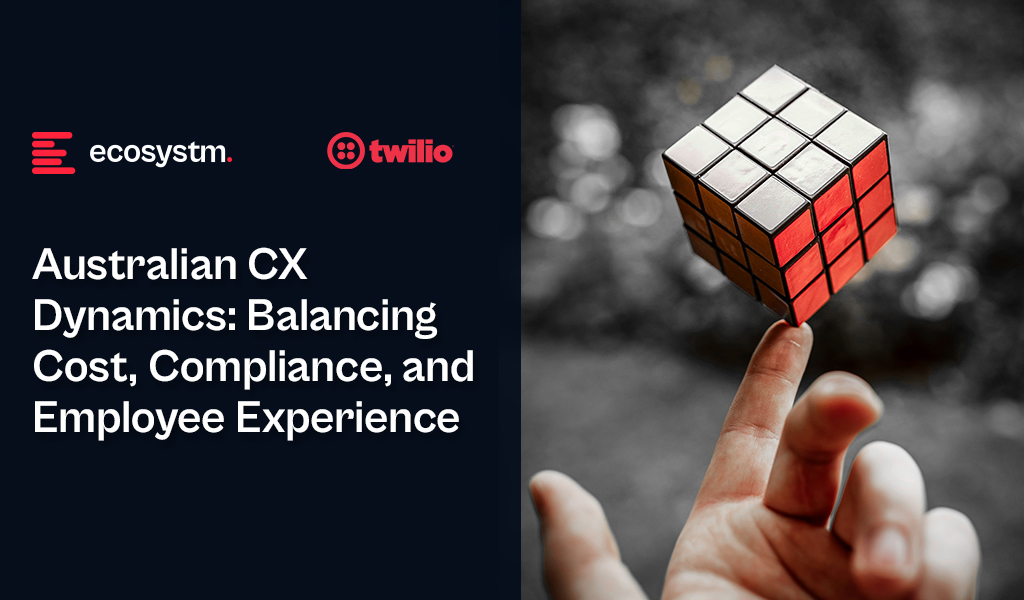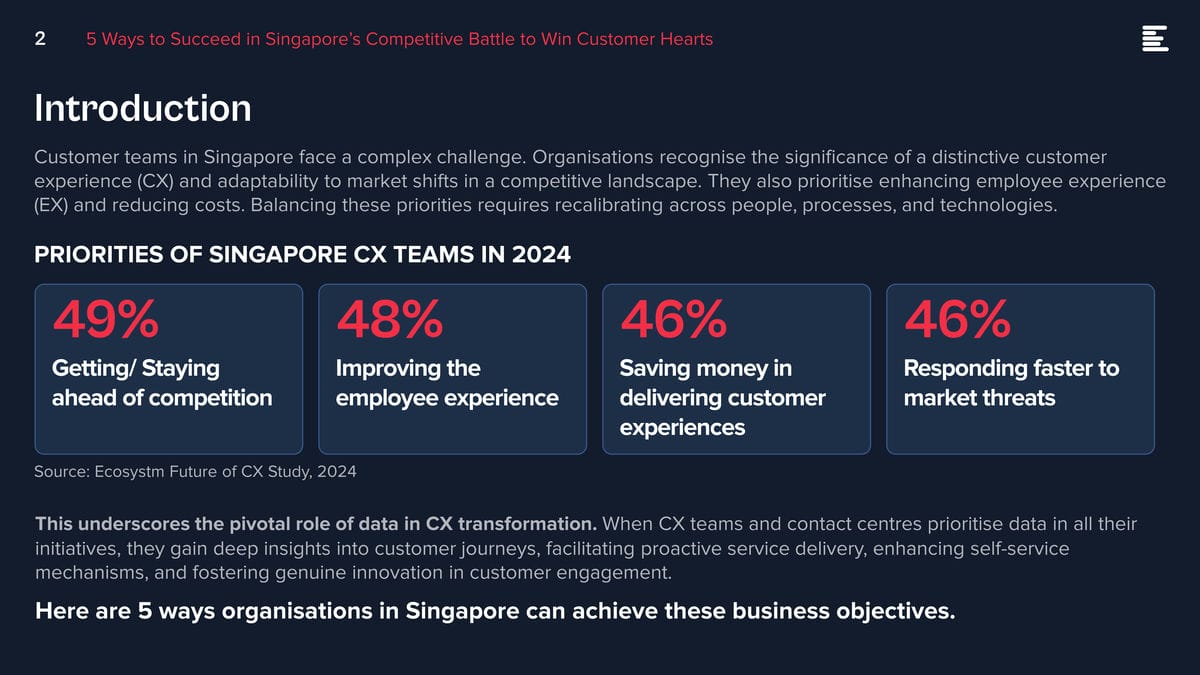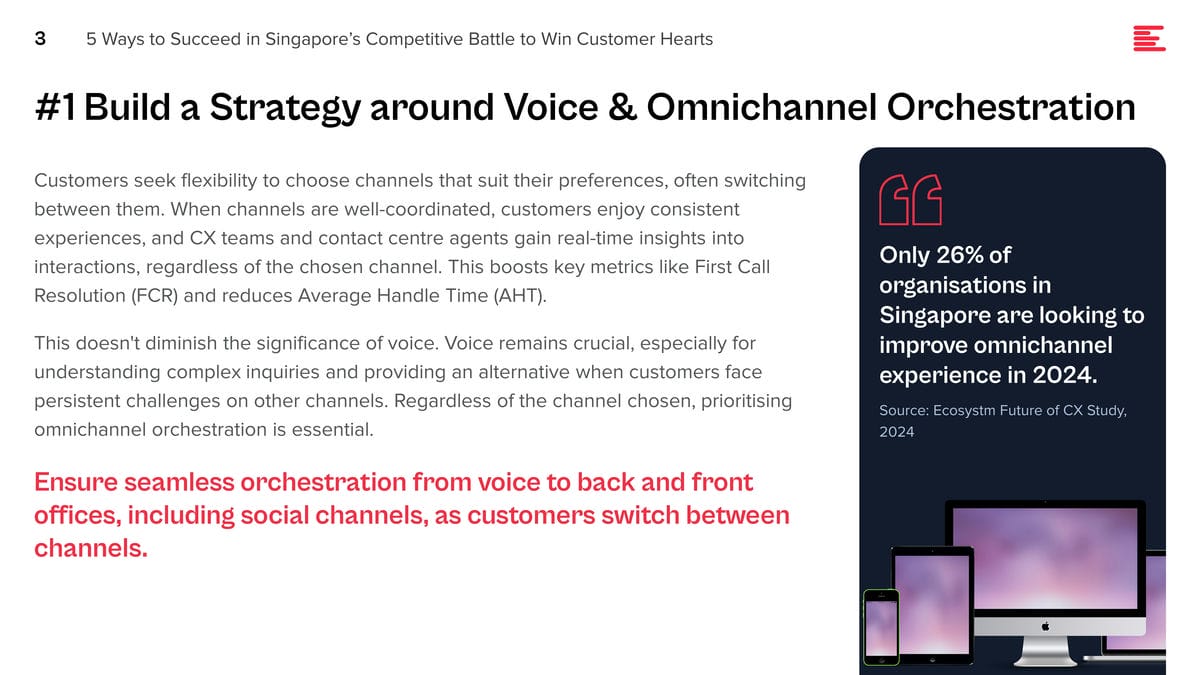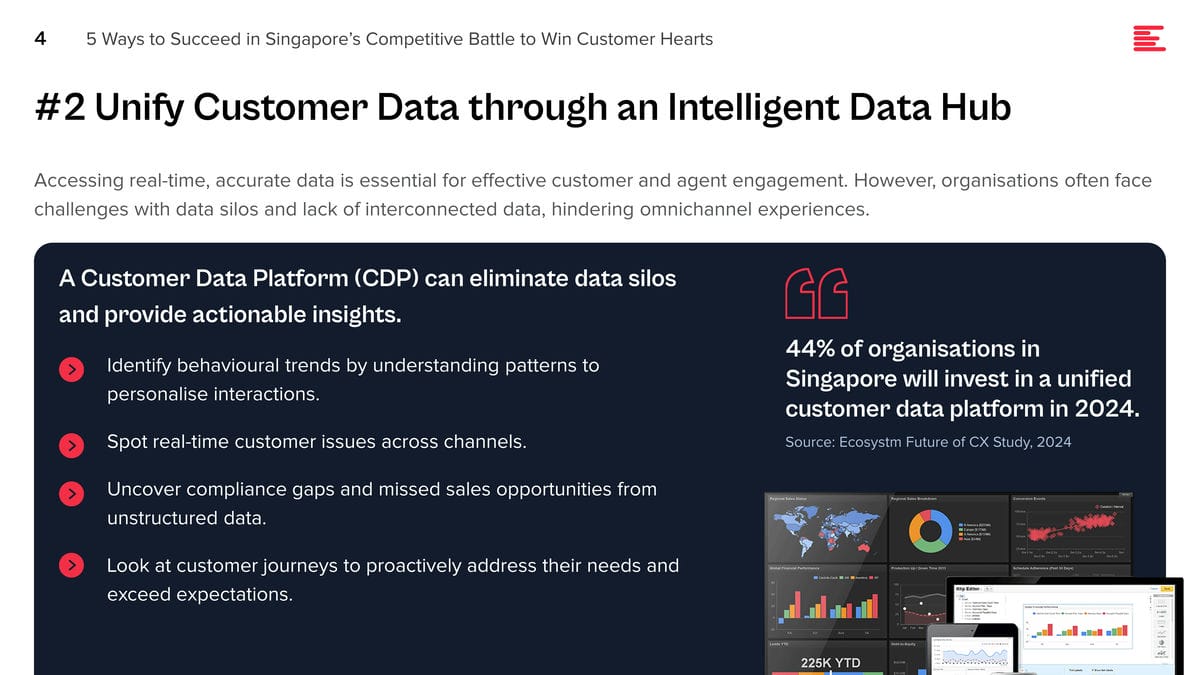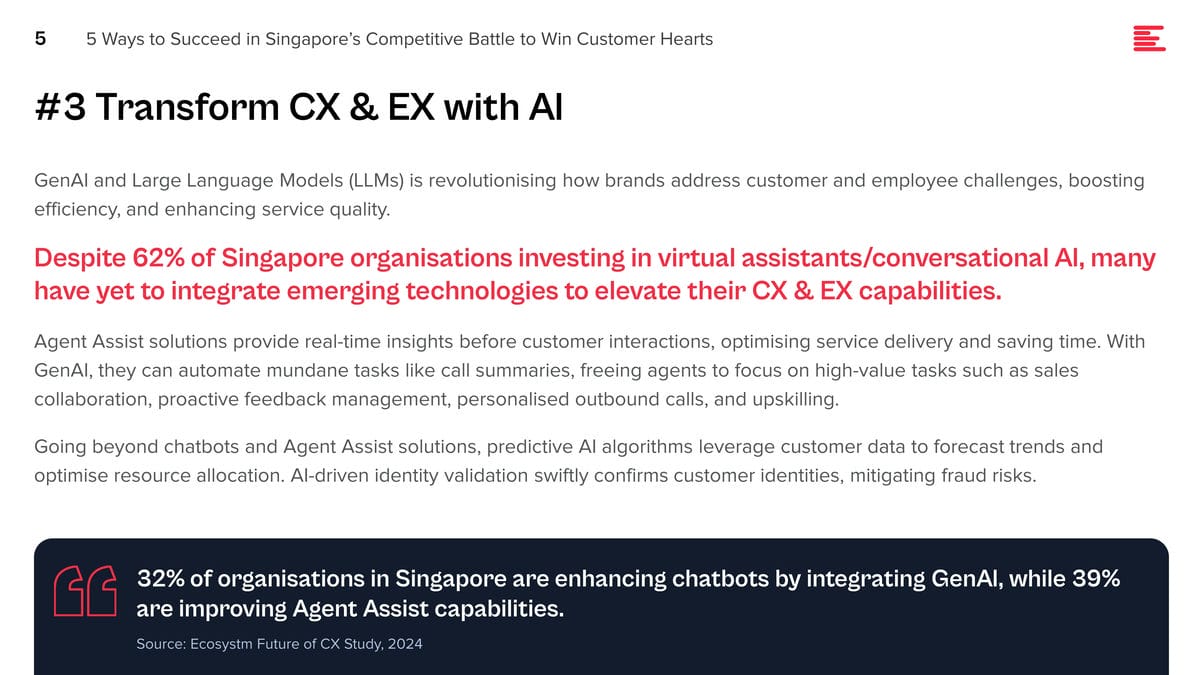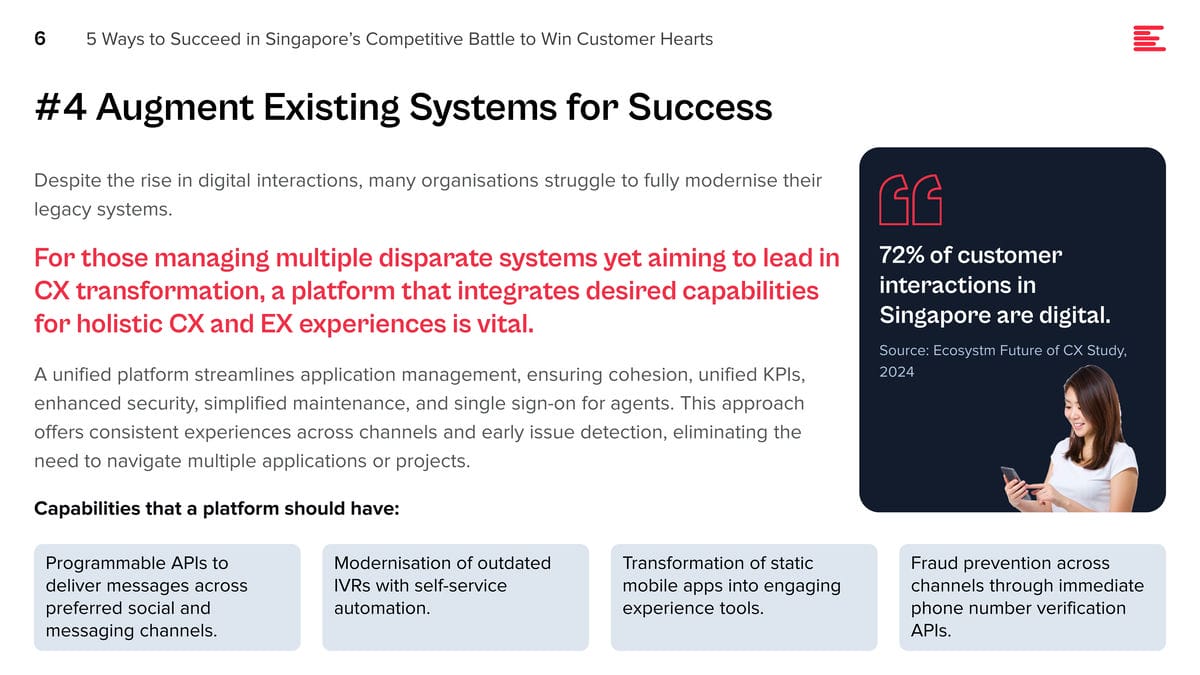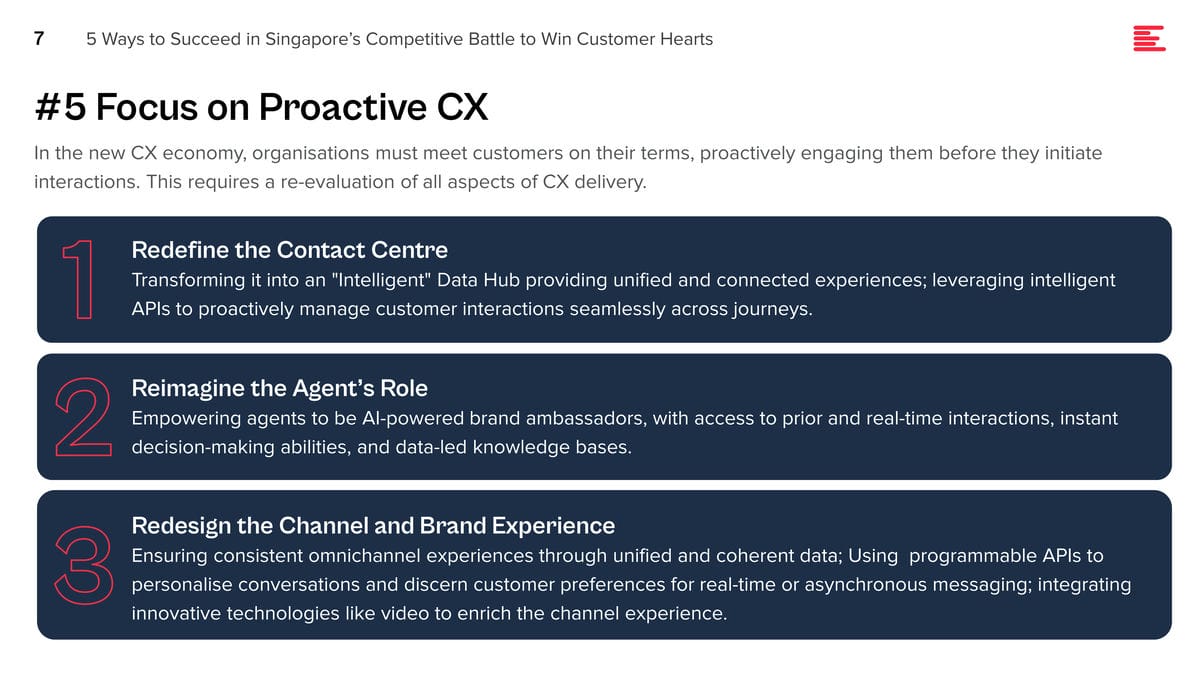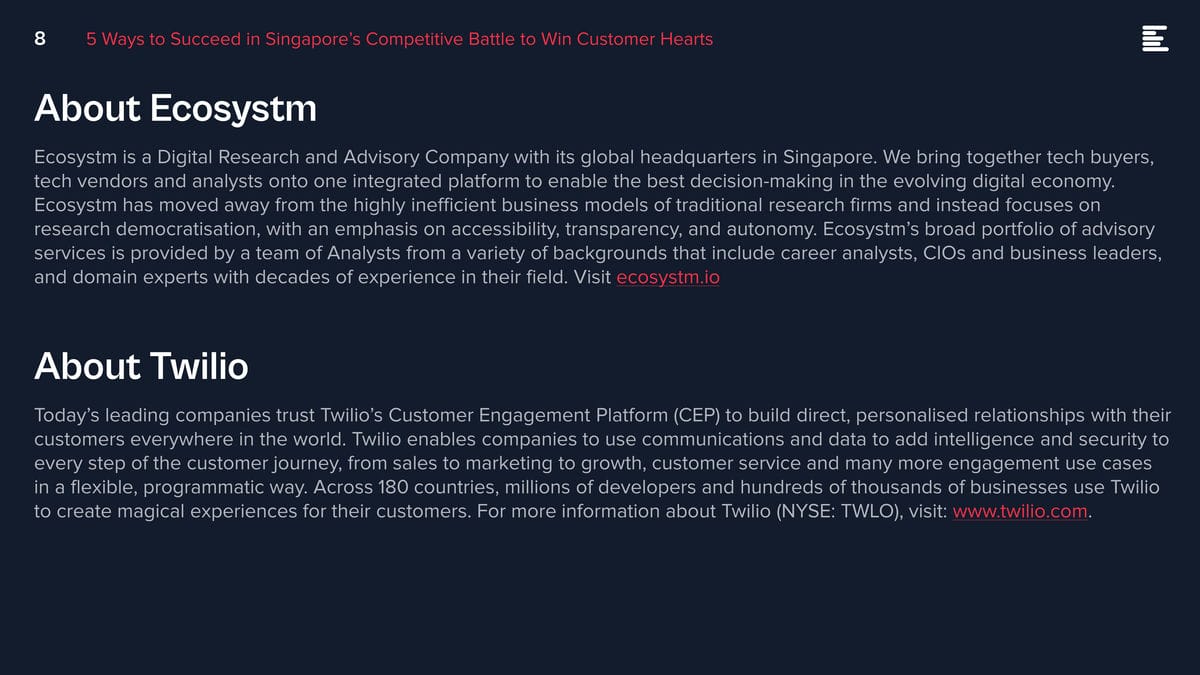CX leaders in Australia are actively refining their customer and employee strategies. Due to high contact centre operational costs, outsourcing to countries like the Philippines, Fiji, and South Africa has gained popularity. However, compliance issues restrict some organisations from outsourcing. Despite cost constraints, elevating customer experience (CX) through AI, self-service, and digital channels remains crucial. High agent attrition also highlights the need to enhance employee experience (EX).

Meeting these challenges has prompted organisations to assess AI and automation solutions to enhance efficiency, cut costs, and improve EX. Australian CX teams hold extensive data from diverse applications, underscoring the need for a robust data strategy – that can provide deeper insights into customer journeys, proactive service, improved self-service options, and innovative customer engagement.
Here are 5 ways organisations in Australia can achieve their CX objectives.
Download ‘Australian CX Dynamics: Balancing Cost, Compliance, and Employee Experience‘ as a PDF.
#1 Prioritise Omnichannel Orcheshtration
Customers want the flexibility to select a channel that aligns with their preferences – often switching between channels – prompting organisations to offer more engagement channels.
Aim for unified customer context across channels for deeper customer engagement.
Coordinating all channels ensures consistent experiences for customers, with CX teams and agents accessing real-time information across channels. This boosts key metrics like First Call Resolution (FCR) and reduces Average Handle Time (AHT).
It is important not to overlook voice when crafting an omnichannel strategy. Despite digital growth, human interaction remains crucial for complex inquiries and persistent challenges. Context is vital for understanding customer needs, and without it, experiences suffer. This contributes to long waiting times, a common customer complaint in Australia.

#2 Eliminate Data Silos
Despite having access to customer information from multiple interactions, organisations often struggle to construct a comprehensive customer data profile capable of transforming all available data into actionable intelligence.
A Customer Data Platform (CDP) can eliminate data silos and provide actionable insights.
- Identify behavioural trends by understanding patterns to personalise interactions.
- Spot real-time customer issues across channels.
- Uncover compliance gaps and missed sales opportunities from unstructured data.
- Look at customer journeys to proactively address their needs and exceed expectations.

#3 Embed AI into CX Strategies
The emergence of GenAI and Large Language Models (LLMs) has thrust AI into the spotlight, promising to humanise its capabilities. However, there’s untapped potential for AI and automation beyond this.
Australian organisations are primarily considering AI to address key CX priorities: enhancing efficiency, cutting costs, and improving EX.

Agent Assist solutions offer real-time insights before customer interactions, improving CX and saving time. Integrated with GenAI, these solutions automate tasks like call summaries, freeing agents to focus on high-value activities such as sales collaboration, proactive feedback management, personalised outbound calls, and skill development. Predictive AI algorithms go beyond chatbots and Agent Assist solutions, leveraging customer data to forecast trends and optimise resource allocation.
#4 Keep a Firm Eye on Compliance
Compliance in contact centres is more than just a legal requirement; it is core to maintaining customer trust and safeguarding brand’s reputation.
Maintaining compliance in contact centres is challenging due to factors such as the need to follow different industry guidelines, constantly changing regulatory environment, and the shift to hybrid work.
Organisations should focus on:
- Limiting individual stored data
- Segregating data from core business applications
- Encrypting sensitive customer data
- Employing access controls
- Using multi-factor authentication and single sign-on systems
- Updating security protocols consistently
- Providing ongoing training to agents
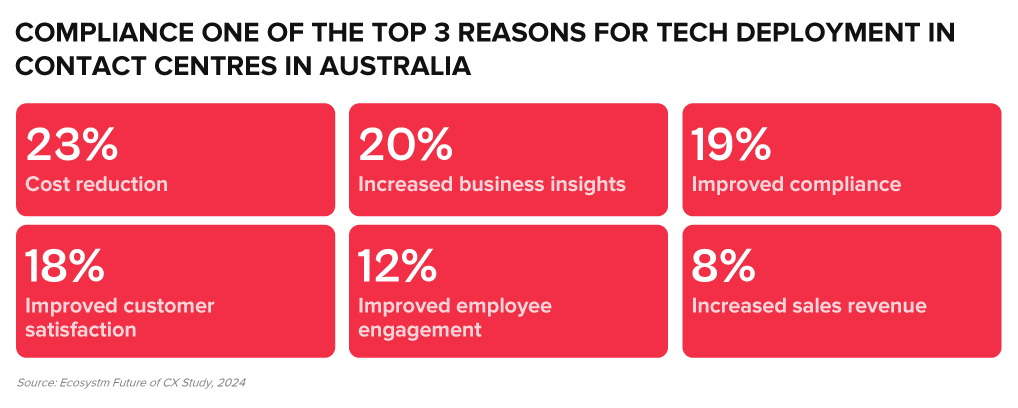
#5 Implement New Technologies with Ease
Organisations often struggle to modernise legacy systems and integrate newer technologies, hindering CX transformation.

Delivering CX transformation while managing multiple disparate systems requires a platform that can integrate desired capabilities for holistic CX and EX experiences.
A unified platform streamlines application management, ensuring cohesion, unified KPIs, enhanced security, simplified maintenance, and single sign-on for agents. This approach offers consistent experiences across channels and early issue detection, eliminating the need to navigate multiple applications or projects.
Capabilities that a platform should have:
- Programmable APIs to deliver messages across preferred social and messaging channels.
- Modernisation of outdated IVRs with self-service automation.
- Transformation of static mobile apps into engaging experience tools.
- Fraud prevention across channels through immediate phone number verification APIs.
Ecosystm Opinion
Organisations in Australia must pivot to meet customers on their terms, and it will require a comprehensive re-evaluation of their CX strategy.
This includes transforming the contact centre into an “Intelligent” Data Hub, leveraging intelligent APIs for seamless customer interaction management; evolving agents into AI-powered brand ambassadors, armed with real-time insights and decision-making capabilities; and redesigning channels and brand experiences for consistency and personalisation, using innovative technologies.

Customer teams in Singapore face a complex challenge. Organisations recognise the significance of a distinctive customer experience (CX) and adaptability to market shifts in a competitive landscape. They also prioritise enhancing employee experience (EX) and reducing costs. Balancing these priorities requires recalibrating across people, processes, and technologies.

This underscores the pivotal role of data in CX transformation. When CX teams and contact centres prioritise data in all their initiatives, they gain deep insights into customer journeys, facilitating proactive service delivery, enhancing self-service mechanisms, and fostering genuine innovation in customer engagement.
Here are 5 ways organisations in Singapore can achieve these business objectives.
Download ‘5 Ways to Succeed in Singapore’s Competitive Battle to Win Customer Hearts’ as a PDF.
#1 Build a Strategy around Voice & Omnichannel Orchestration
Customers seek flexibility to choose channels that suit their preferences, often switching between them. When channels are well-coordinated, customers enjoy consistent experiences, and CX teams and contact centre agents gain real-time insights into interactions, regardless of the chosen channel. This boosts key metrics like First Call Resolution (FCR) and reduces Average Handle Time (AHT).
This doesn’t diminish the significance of voice. Voice remains crucial, especially for understanding complex inquiries and providing an alternative when customers face persistent challenges on other channels. Regardless of the channel chosen, prioritising omnichannel orchestration is essential.
Ensure seamless orchestration from voice to back and front offices, including social channels, as customers switch between channels.

#2 Unify Customer Data through an Intelligent Data Hub
Accessing real-time, accurate data is essential for effective customer and agent engagement. However, organisations often face challenges with data silos and lack of interconnected data, hindering omnichannel experiences.
A Customer Data Platform (CDP) can eliminate data silos and provide actionable insights.
- Identify behavioural trends by understanding patterns to personalise interactions.
- Spot real-time customer issues across channels.
- Uncover compliance gaps and missed sales opportunities from unstructured data.
- Look at customer journeys to proactively address their needs and exceed expectations.

#3 Transform CX & EX with AI
GenAI and Large Language Models (LLMs) is revolutionising how brands address customer and employee challenges, boosting efficiency, and enhancing service quality.
Despite 62% of Singapore organisations investing in virtual assistants/conversational AI, many have yet to integrate emerging technologies to elevate their CX & EX capabilities.
Agent Assist solutions provide real-time insights before customer interactions, optimising service delivery and saving time. With GenAI, they can automate mundane tasks like call summaries, freeing agents to focus on high-value tasks such as sales collaboration, proactive feedback management, personalised outbound calls, and upskilling.
Going beyond chatbots and Agent Assist solutions, predictive AI algorithms leverage customer data to forecast trends and optimise resource allocation. AI-driven identity validation swiftly confirms customer identities, mitigating fraud risks.

#4 Augment Existing Systems for Success
Despite the rise in digital interactions, many organisations struggle to fully modernise their legacy systems.
For those managing multiple disparate systems yet aiming to lead in CX transformation, a platform that integrates desired capabilities for holistic CX and EX experiences is vital.
A unified platform streamlines application management, ensuring cohesion, unified KPIs, enhanced security, simplified maintenance, and single sign-on for agents. This approach offers consistent experiences across channels and early issue detection, eliminating the need to navigate multiple applications or projects.
Capabilities that a platform should have:
- Programmable APIs to deliver messages across preferred social and messaging channels.
- Modernisation of outdated IVRs with self-service automation.
- Transformation of static mobile apps into engaging experience tools.
- Fraud prevention across channels through immediate phone number verification APIs.

#5 Focus on Proactive CX
In the new CX economy, organisations must meet customers on their terms, proactively engaging them before they initiate interactions. This will require organisations to re-evaluate all aspects of their CX delivery.
- Redefine the Contact Centre. Transform it into an “Intelligent” Data Hub providing unified and connected experiences. Leverage intelligent APIs to proactively manage customer interactions seamlessly across journeys.
- Reimagine the Agent’s Role. Empower agents to be AI-powered brand ambassadors, with access to prior and real-time interactions, instant decision-making abilities, and data-led knowledge bases.
- Redesign the Channel and Brand Experience. Ensure consistent omnichannel experiences through data unification and coherency. Use programmable APIs to personalise conversations and identify customer preferences for real-time or asynchronous messaging. Incorporate innovative technologies such as video to enhance the channel experience.



